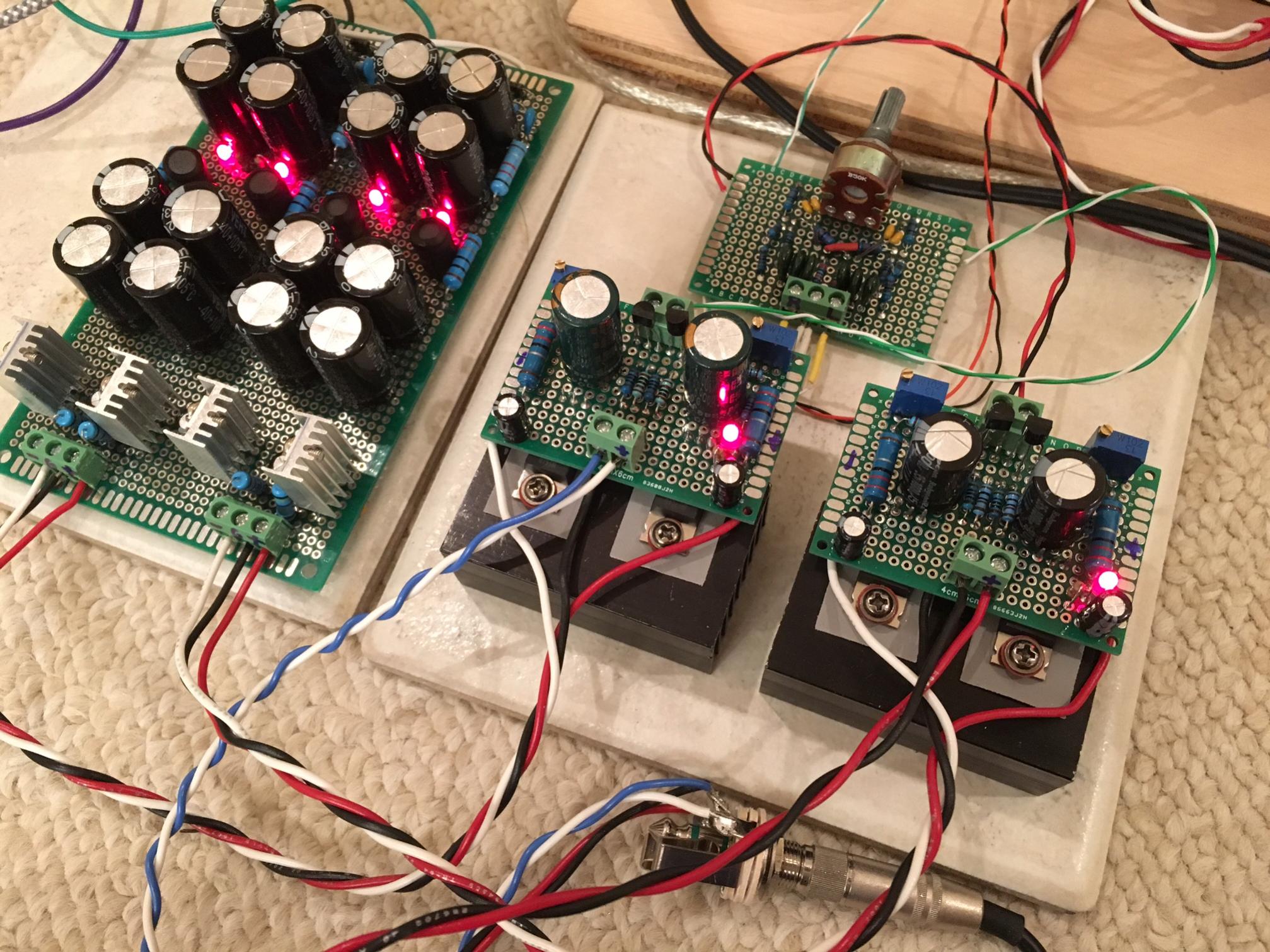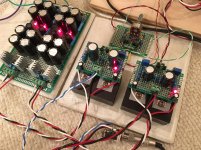> no 100k to ground and no 100R series between input to the two 100R's in front of JFET gates
They might have saved your MOSFETs.
In fact, reducing the 100k to 10k will be even more effective in tying the input to Gnd when source RCA is open circuit.
So not circuit design fault from me.
Patrick
I think you are right. When I built the circuit I followed the veroboard design of post 1 which doesn't have those resistors on input. After seeing schematic with it I added to left amp. I then installed left amp with it to test. Then plugging in source to both killed the right amp which did not have those two extra resistors.
I like 22k input impedance to 47k input inpedance - but they would be better than 100k even to prevent floating input. What exactly causes it to burn out as gates need more than 20v for damage or is damage really above 12v be less than 15v even?
Would be a pity to burn your 2013/313, wouldn't it ? 😉
Matched-pair yield of Fairchild is quite bad, as published before.
Patrick
I know what yo mean that's why I will leave them for the last and smoke all the IRF first.
I never had a burnt MOSFET, so I would not know why.
Nor do I intend to.
😉
All the builders till now have XFD, which guarantees input is tied to Gnd.
Patrick
Nor do I intend to.
😉
All the builders till now have XFD, which guarantees input is tied to Gnd.
Patrick
I think you are right. When I built the circuit I followed the veroboard design of post 1 which doesn't have those resistors on input. After seeing schematic with it I added to left amp. I then installed left amp with it to test. Then plugging in source to both killed the right amp which did not have those two extra resistors.
I like 22k input impedance to 47k input inpedance - but they would be better than 100k even to prevent floating input. What exactly causes it to burn out as gates need more than 20v for damage or is damage really above 12v be less than 15v even?
I don't have the resistors and I've hot swapped mine 100s of times probably, always with the volume knob down. No problems so far but I probably won't be doing it again.
These are the very first MOSFETs I have burned out and I have used IRFP240/9240 extensively before (20 pairs+) in many projects. Anyhow, will have order more IRF610/9610's - at least they are cheap. Desoldering point to point is not fun though as many connections have to be manually redone.
I might add 12v Zener clamps in a fashion that allows easy removal (clip off) and see if I hear a difference in SQ.
I might add 12v Zener clamps in a fashion that allows easy removal (clip off) and see if I hear a difference in SQ.
I doubt the Zener would have saved them. The FETs will take +/-20V on the gate.
The current limiter probably would.
And if you do have a floating input cauing a large voltage at the gate, I am sure your headphone (when connected) will die first due to over current.
But try it by all means.
For me, it is a self-made problem in the first place.
Patrick
The current limiter probably would.
And if you do have a floating input cauing a large voltage at the gate, I am sure your headphone (when connected) will die first due to over current.
But try it by all means.
For me, it is a self-made problem in the first place.
Patrick
F5H as buffer
Hi Patrick,
Do you think that this topology can serve as a unity gain buffer by bypassing the feedback resistor? Perhaps some other changes are required for stabilization?
I appreciate your comments before trying to reduce the chance of frying the expensive input jfets on oscillation or something else unaccounted for.
Hi Patrick,
Do you think that this topology can serve as a unity gain buffer by bypassing the feedback resistor? Perhaps some other changes are required for stabilization?
I appreciate your comments before trying to reduce the chance of frying the expensive input jfets on oscillation or something else unaccounted for.
As unity gain buffer, you probably don't need a TO220 power MOSFET. I think the feedback and shunt resistor values need to be the same for 1x gain. Which way to make them I don't know, there is a best way and EUVL would know.
For unity buffer, tale a look at the JLH buffer at the bottom of this page :
The Class-A Amplifier Site - JLH Headphone Amplifiers
Patrick
The Class-A Amplifier Site - JLH Headphone Amplifiers
Patrick
What do you think of this case for $39 (shipping incl) for the F5 HA? The sides appear to be solid aluminum and the MOSFETs could just be screwed to it for heatsink. I found each amp channel was about 3w so should be able to dissipate. I like how IEC cutout and all holes and knobs in place already. Those basics are a huge plus compared to cutting your own.
https://www.aliexpress.com/item/220...r-enclosure-AMP-BOX-PSU-CASE/32619925540.html
Internal dimensions: 200mm x 41mm x 77mm

https://www.aliexpress.com/item/220...r-enclosure-AMP-BOX-PSU-CASE/32619925540.html
Internal dimensions: 200mm x 41mm x 77mm

Thanks. I'll proceed to trial since I can not see glaring problem either. What I plan is a ~10W buffer, hoping that this topology gives a bit more clarity compared to a regular diamond buffer.
Actually it won't fit there either. Since I plan to use dual 15V supply, I figure posting my question here is more appropriate. I can manage parts selection and biasing, but rather uncertain about any need for compensation to prevent oscillation due to change in CLG. Since your F5H use none and neither F5 nor the JLH buffer, I figure a trial will not be too risky. I think I'll add an output zobel network just in case. Thanks for your comments.
What do you think of this case for $39 (shipping incl) for the F5 HA? The sides appear to be solid aluminum and the MOSFETs could just be screwed to it for heatsink. I found each amp channel was about 3w so should be able to dissipate. I like how IEC cutout and all holes and knobs in place already. Those basics are a huge plus compared to cutting your own.
https://www.aliexpress.com/item/220...r-enclosure-AMP-BOX-PSU-CASE/32619925540.html
Internal dimensions: 200mm x 41mm x 77mm

I think it would work depending on how much heat your regulator puts out. But if you want the ability to bias heavy I'd go with the 2107. Only $30 more. I have mine at work on a desk with 2 30" monitors, about 5 USB hard drives and other hot stuff. I appreciate that it stays coolish. And I bet my coworkers do too. I have a tube amp too that freaks them out.
I just found out my problem - it wasn't the IRF610/9610's that burned out - it was my headphones. Luckily they are just the basic test iPhone earbuds - now one side is fried. It must have hit xmax and the suspension got destroyed hence the crackling sound. I have my good headphones in and am careful to power down before plugging in or disconnecting.
The sound with good headphones is quite profound. Very very good. The bass is quite amazing and the lack of any audible distortion is very apparent. My phones are too sensitive and i need to add a volume pot in a hurry.
Anyhow, the F5 HA never got damaged from the hot plug - it was the phones. I did install the 100k resistor to ground to prevent it from floating.
The sound with good headphones is quite profound. Very very good. The bass is quite amazing and the lack of any audible distortion is very apparent. My phones are too sensitive and i need to add a volume pot in a hurry.
Anyhow, the F5 HA never got damaged from the hot plug - it was the phones. I did install the 100k resistor to ground to prevent it from floating.
You can install my protection circuit which can also be built P2P with some skills.
http://www.diyaudio.com/forums/headphone-systems/292681-xen-shpp-simple-headphone-protection.html
Patrick
http://www.diyaudio.com/forums/headphone-systems/292681-xen-shpp-simple-headphone-protection.html
Patrick
Last edited:
Volume with Passive Cross Feed filter built. It's nice to have a volume knob. I did not have any 22nF film caps so using two 10nF ceramic caps for now. It sounds very good but have not had a chance to do an AB comparison without cross feed yet. I only had a 50k linear pot so used a 47k resistor in parallel with it vs the recommended 12k. Seems to control volume well though.
This amp is basically ready to go in a box - sounds excellent.

A clamp on inductive ammeter shows 80mA of 120vac or 10w total wall plug power. This is biased at 100mA. It seems that the small 10VA toroidal transformer may actually be enough (although I just ordered the 50VA one). Antek says that their trafos can easily handle 20% more than rating.
This amp is basically ready to go in a box - sounds excellent.

A clamp on inductive ammeter shows 80mA of 120vac or 10w total wall plug power. This is biased at 100mA. It seems that the small 10VA toroidal transformer may actually be enough (although I just ordered the 50VA one). Antek says that their trafos can easily handle 20% more than rating.
Attachments
Last edited:
- Home
- Amplifiers
- Pass Labs
- F5 Headamp ?
